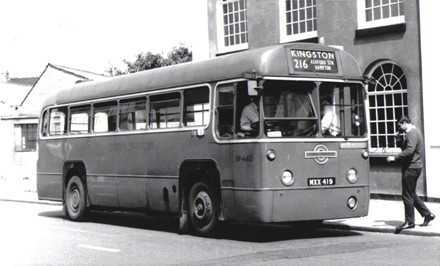|
|
Running numbers - RF
services
Page last updated 30 January 2016
As noted on the previous page, it was
usual practice in the Central Area for the running number sequence
for each route to start at 1, even though this resulted in several
buses from each garage carrying each number. This applied to
all RF routes up to the early 1970s, with the exceptions noted
below.
Although some double-deck routes operated by different garages
used different number sequences at different garages, this does not
seem to have applied to RF routes. The 210 (on Sundays, when it was shared between
Muswell Hill (MH), Leyton (T) and Tottenham (AR)), ran MH1-8, T1-7
and AR1-9 (sceptics may wish to peruse an extract from the
1967 Time Schedule, here); the
236 was similar. And there is the
case of the 213, as shown in the
photographs on the previous page.
Exceptions
Barking (BK)
Barking was a relative late-comer to single-deck operation, on
commencement of the 291 in 1965.
Initially it used running numbers 301 upwards, later changed to 171
upwards.
Kingston (K)
The position at Kingston is somewhat unclear. Firstly, at
various times before and during RF operation, the 215, 218 and
219 were jointly compiled, either on
Sundays or all week, as well as the 215 and 215A being joint (Mon-Sat) throughout
the operation of the latter. There was also a degree of
cross-linking. As with the 213, the running numbers used on
the jointly compiled 218/219 exceeded the PVR for the routes, which
may be a legacy from joint 215 compilation. Before the
RF era, when Kingston ran new route 264
in 1950-51 and the route was jointly compiled with the 218 on
Mon-Fri, workings included K34 and K67 although the PVR was
6. It is not known what running numbers were used when
Kingston regained part of the route in 1962-63. Without the
time and duty schedules for the various years, it may not be
possible to establish exactly how the workings were arranged.
Loughton (L)
Loughton used numbers from 1 upwards, but changed at some
time after the introduction of RFs in 1953 and before 1958, when
the sequence used by the 254 changed to
(about) L85 upwards. The 20B series included L26.
North Street (NS)
North Street followed the practice at Hornchurch (RD), from
where the 250 was transferred when it
opened in 1953, in using a sequence from 50 upwards. RD had,
like U and BK, always used a single sequence.
Southall (HW) (renamed from Hanwell in 1950)
Southall used numbers from 1 upwards until commencement of the
summer schedules of 1956 (before the introduction of RFs), when the
211 used 165 upwards.
Uxbridge (UX)
Uxbridge converted from the old system at some time after
1955. During the crew operated phase of RF
operation, in the late 50s and early 60s, the running number
sequences included:
222
UX51 upwards
224
UX75-81
224A/B UX90-93;
224B as a separate sequence (1959-61) not known
224C as
for 222 (224C replaced 222)
However, cross-linking over the
years between various of the Uxbridge single-deck routes (see for
example the allocations for the 224B) meant that these numbers could
also appear on buses working other routes. On the
re-introduction of RF operation in 1971, new sequences were in use
including:
204
UX31 upwards
223
UX53-56
224
UX61-65, UX83-84
224B
UX58-61 (possibly cross-linked workings?), UX71
Changes in the 1970s
The general change in the early 1970s to a single sequence of
running numbers for each garage naturally affected RF workings;
except at Kingston (where the 218/219 kept the first series),
running numbers took higher ranges. Those we have identified
either from photographs or from time schedules are as
follows; with the exception of MH27 in 1971, the
remainder (where dated) are from 1975 onwards:
The information throughout this section is woefully incomplete -
further detail welcome!
|

Usually, each route at a
garage had a running number sequence starting at 1.
In this pair of pictures, a
215 and a 216
are running K3.
(Above) On the 215, RF332 is
followed by 1424 on the 602, RF436 on the 216 and
a roofbox RT on the
131. It is early 1961 in Kingston.
Photo © D Battams
(Below) Seven years later,
RF442 sets off back to Kingston from Staines.
Photo © Alan Cross,
Peter Gomm collection

|